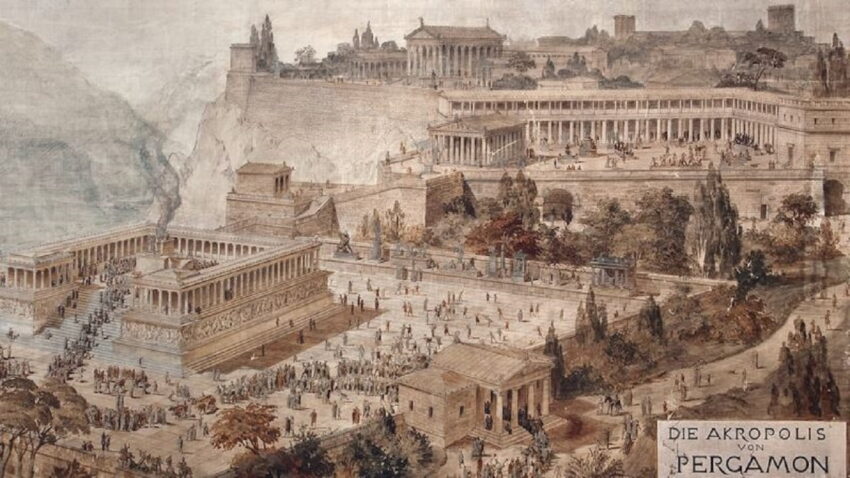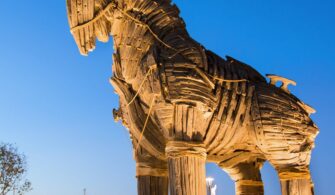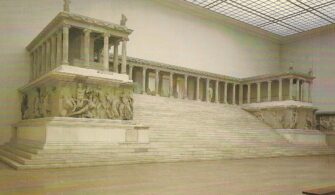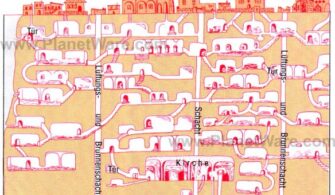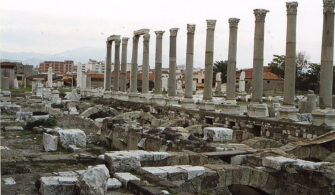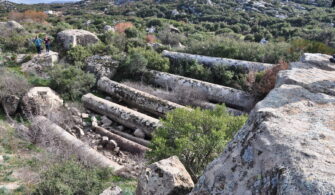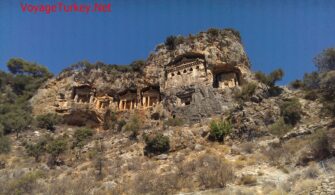With its historical and cultural richness, Pergamon is one of the most important cultural and tourism centers of the Aegean.
Location of Pergamon
This ancient city is located in the district of Bergama, 100 km from İzmir/Turkey.
History of Pergamon
Pergamon was one of the important trade centers in the Mysian region during the ancient period. Its history goes back to the 7th century BC. Pausanias said that Pergamon was founded by the Pergamus, son of Andromaque. On the other hand, the son of Heracles Telephos is shown as the founder of Pergamon. In the ancient texts, the name Pergamon is mentioned for the first time in Xenophon’s ‘The Return of the Ten Thousand”
Alexander the Great took Pergamon together with all Western Anatolia in 334 BC under the domination of the Kingdom of Macedonia. When Macedonian Emperor, Alexander the Great died in 323 BC, his generals inherited his land and reign. After Alexander’s death, the territories of the Empire were shared among his generals. In 301 BC, Macedonian Commander Lysimachos, who conquered the Pergamon region, declared his kingdom.
Attalids, one of the Alexander the Great’s generals ruled the city of Pergamon in Asia Minor after the death of Lysimachus. When Attalids saw the hilltop of Pergamon as geographically desirable, he built the city of Pergamon.
Pergamon became the capital of the Pergamon Kingdom under the rule of Attalids. Thus the city was named after Pergamos. When it became the capital, buildings such as palaces, temples and theatres were built in the city.
Pergamon was an important major historical, cultural and commercial centre for a period of 150 years, from 283 to 133 BC.
After the Pergamon Kingdom was left to the Roman Empire (133 BC), it became the capital of the Asian province of Rome and was given the title of Néocore, the Guardian of the Shrines. After it was annexed to Rome, Pergamon remained as one of the leading cities in Western Anatolia. During this period Pergamon started giving the most authentic works in literature, art, science, health, and architecture.
This ancient city maintained its position as an important trade center during the Byzantine Empire, Karesioğulları Principality, and the Ottoman Empire. It was one of the leading centers of the Ottoman Empire.
Buildings in Pergamon
There are many ancient buildings in the city. See map below.
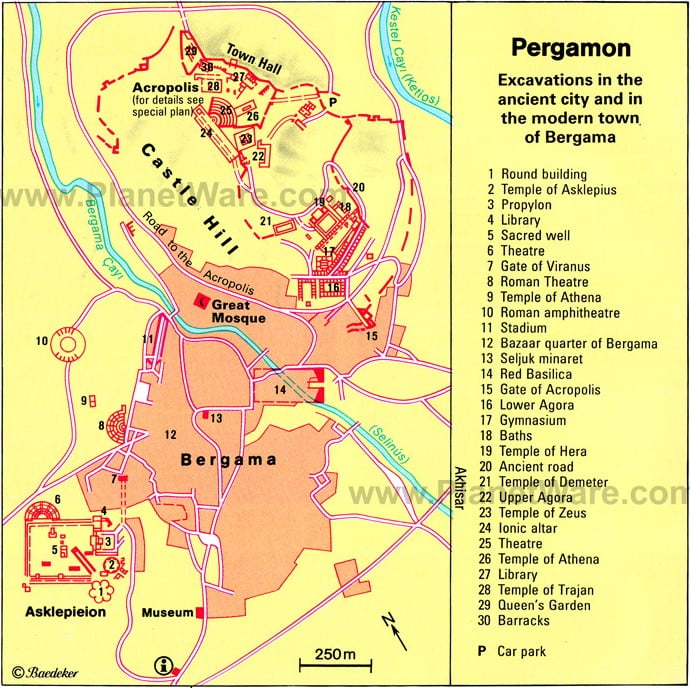
Acropolis of Pergamon
Acropolis, which literally means “upper town” or “a high city” has the most important remains of Pergamon. The hill that the acropolis is located on about 300 meters high.
Acropolis, the oldest and directorial center of Pergamon is was built on the top of a hill very steep, controlling the Kaikos Plain. Due to the position of Acropolis, it’s believed that the name of the city “Pergamon” is derived from the words “High Settlement” in Hittite Language.
It can be reached via a path about 300 meters long. The acropolis of Pergamon has served as a settlement since ancient times. There were a series of buildings that accommodated any governmental, religious, social, military and commercial usage.
The acropolis of Pergamum can be seen on a day tour from Izmir or you can stay overnight in the nearby town of Bergama. 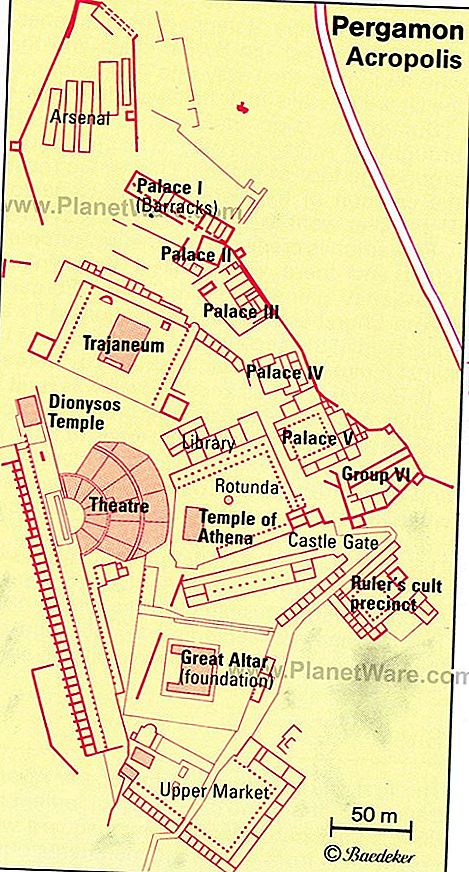 It is divided into two sections: Upper Acropolis include the Hellenistic Theater, Trajaneum, Atheneum, Sanctuary of Athena, and Royal Palaces.
It is divided into two sections: Upper Acropolis include the Hellenistic Theater, Trajaneum, Atheneum, Sanctuary of Athena, and Royal Palaces.
The top of the hill in the Upper Acropolis accommodates the Palaces (Royal Palaces) of the Kings of Pergamon. The ruins of the Pergamon Kings’ palaces are located to the east of the library.
Temple (Altar) of Zeus was built with much care and precision on the terrace beneath them.
Upper Acropolis of Pergamon was also home to one of the steepest theatres in the world: Pergamon Theatre
In addition, there is a library which was the second most important library in ancient times, after the library in Alexandria: Pergamon Library
Temple (Sanctuary) of Athena in Pergamon is located in the upper section of the buildings. The Temple of Trajan in Pergamon was built on the highest terrace in the acropolis.
On the northern edge of the acropolis, The Arsenals were located beyond the palaces and the Temple of Trajan. These five long structures parallel to each other are known as “the depot for military supplies”.
The upper acropolis was also includes the Temple of Dionysos in Pergamon, Turkey.
Lower Acropolis includes the Temple of Demeter, a gymnasium, Sanctuary of Hera, House of Attalus, Lower Agora, and Gate of Eumenes.
Pergamon Library (no: 27 on the map above),
The Pergamon library was one of the biggest libraries of the Hellenistic world. It was the second most important library in ancient times, after the library in Alexandria. According to the Greek historian Plutarch, the Library collection consisted of 200 thousand books including bundles of papyrus and parchment.
"Parchment
Produced from leather of animal, this writing material which took its name from Pergamon had been the most important means of transmission of science and culture during the antiquity, as it was used in production of writing bundles and books.
Invented under the patronage of Eumenes of Pergamon parchment was the substitute for papyrus which was prohibited from export by the Egyptian Ptolemies who thought the Library of Pergamon as rival to Library of Alexandria. During the Pergamon
Kingdom use of parchment had become widespread and more functional."Who established the Pergamum Library?
Pergamon Library, which has much fame and popularity in the 2nd century B.C., was built during the reign of Attalos I. It was created by the transformation of Athena Temple into a “Science Temple”.
The library, which originally was accessed through the upper floor of the gallery, accommodates a large reading room from the era of Eumenes II. The library was equipped with shelves, and 3.50 m. high statue of Athena that was originally in there, is now in the Berlin Museum. In the time of Eumenes II, the collection of the Pergamon Library became richer and the Alexandria Library was its biggest rival.
The library housed the statue busts of the historian Herodotus from Halicarnassus, a female poet Sappho from Lesbos, the scholar Apollonius, who was the son of Philotas, vellum makers Krates and Irodikos, and the musician Timotheus from Miletus.
Disturbed by the grandeur of Pergamon Library, the Egyptian King prohibited papyrus exports to Pergamon, in an attempt to weaken the competition. He wanted the Library in Alexandria to be unrivaled. Krates, an artist from Sardes, offered a solution to this problem. The material he made from goat leather was called Pergamon Paper (Pergaminae Charte), and this was successfully used in place of papyrus. This Pergamon Paper, which was a very important invention, later became known as Parchment.
The invention of Parchment led to a rich literary collection in Pergamon. When the city came under the rule of Rome in 133 B.C., the works from the Pergamon Library were taken to Alexandria, and given to the Egyptian Queen Cleopatra as a gift from Antonius, ignoring the Roman scholars who wished to obtain them.
Books in the Library had been given to the Queen of Egypt Cleopatra as a present by the Roman general and politician, Marcus Antonius in 41 BC.
Temple (Sanctuary) of Athena Polias in Pergamon: The Oldest Temple of Anatolia (no: 26 on the map above),
The Temple of Athena which was built on a point of the Pergamon acropolis that dominates the city and the sea is the first and only Doric Temple of Archaic Anatolian architecture. It was the oldest temple built in ancient times in Anatolia.
The temple, estimated to have been completed in 525 BC, was dedicated to Goddess Athena Polias. It was built in commemoration of the Goddess of Athena, “the messenger of victory”, “protector of the city” and “goddess of wisdom and victory”.
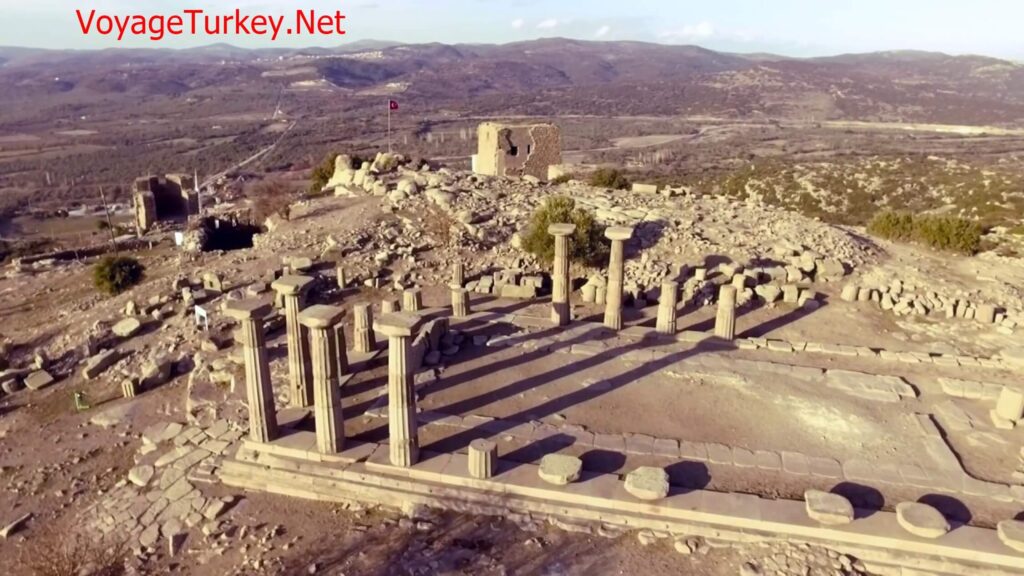
The andesite stone extracted from the nearby quarries was used in the temple. The durability of the andesite stone, which is difficult to process, has brought the temple to the present day.
The crepe of the temple consists of 2 steps. Originally built by carving rocks, the temple was further strengthened with andesite stones over time. In other words, the temple rests on a ground consisting of 2 steps.
The temple is surrounded by 6 dor columns on the short side and 13 on the long side.
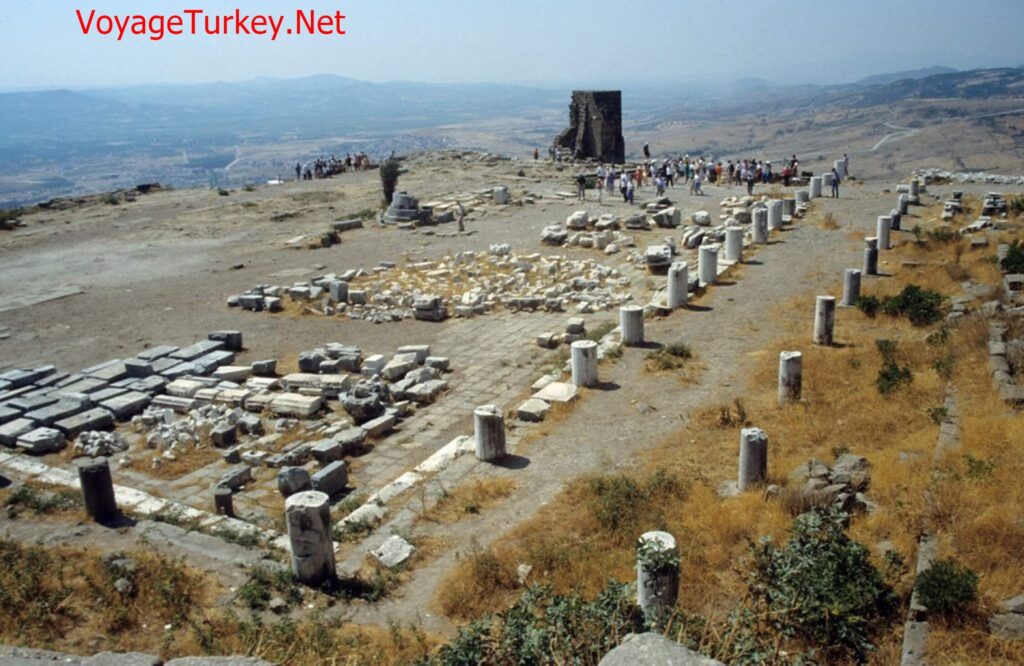
The altar of Temple which was built inside or outside the temple for sacrifices to the gods as a tradition in ancient Greek temples was not found in the temple. It is estimated that the altar of the temple used to offer votive offerings to the gods might have been destroyed during the Byzantine period.
The Propylon of the Temple of Athena was smuggled to Germany in the 19th century. It is currently exhibited at the Berlin Museum.
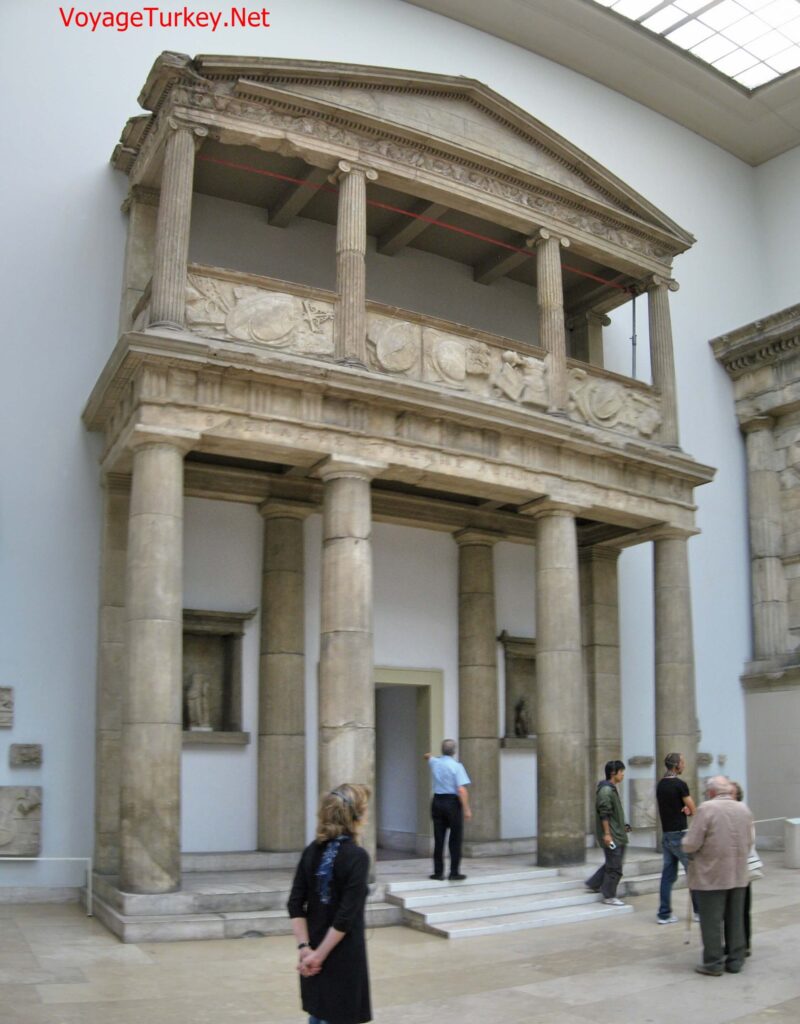
Propylon is an outer monumental gateway standing before a main gateway. Propylon, built by Eumenes II of Bergama at the beginning of the 2nd century BC, consists of two floors. There are 4 Doric columns on the ground floor and 4 Ionic columns and armor-weapon reliefs on the upper floor. Above the ground floor, there is an inscription dedicated to Eumenes by Athena Nikephoros. The inner structure of the temple consists of a front room called “pronaos” and a sacred room called “naos”.
Thus the Sanctuary had been the science and art center of the Acropolis beside its religious role. The temple was transformed into a library later.
Temple (Altar) of Zeus
Temple (Altar) of Zeus (no: 23 0n the map),
Pergamon Theatre (no: 25 in the map),
On the steep slope to the west of the Temple of Athena in the Acropolis of Pergamum, there is a theater of approximately 10,000 people. Rising on a steep slope, the Pergamon Theater is one of the most beautiful architectural works of the Hellenistic period with its impressive appearance.
This theater has a magnificent view and wonderful acoustics.
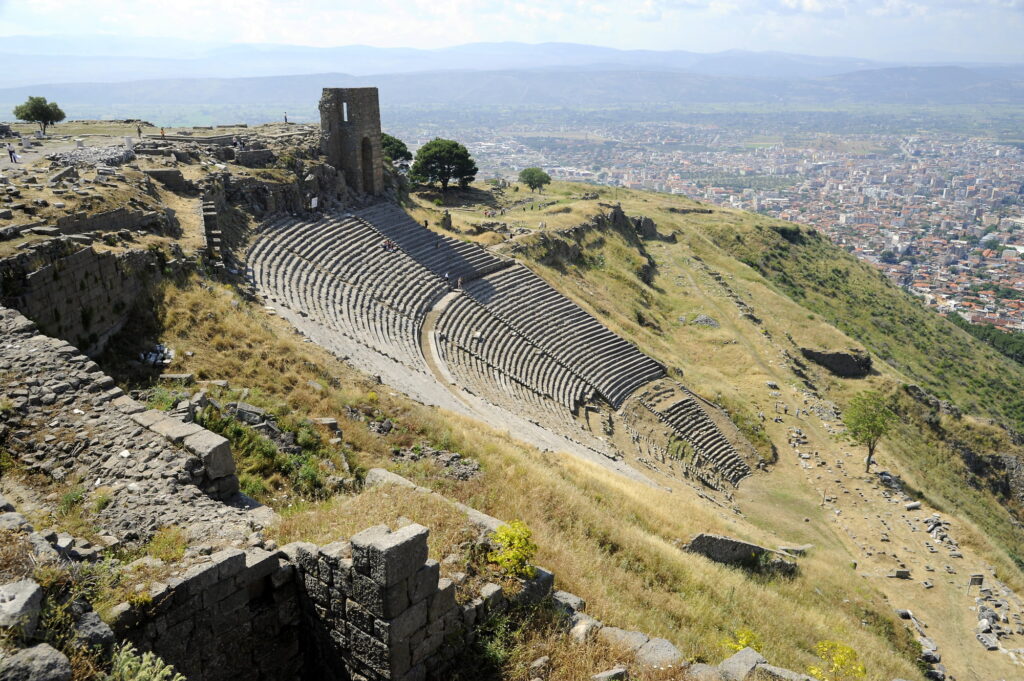
The first theatre on the site was built in the earliest days of the Attalid Kingdom.
The theatre, which is the steepest theatre in Western Anatolia, has a 10 thousand-seat capacity. The theatre at Pergamum has seventy-eight rows of seats and is divided into three horizontal seating sections. The portable wooden stage building is unique – set up only on performance days and removed once the performance ended.
It has so many characteristics: 80 rows of very tall steps, with the highest situated about 36 meters above the orchestra pit; it could seat 10,000 spectators. Another interesting element is the presence of a terrace 246 meters long, a singular porticus post scaenam, with a covered Doric portico leading to the Temple of Dionysus, installed in its northernmost extremity.
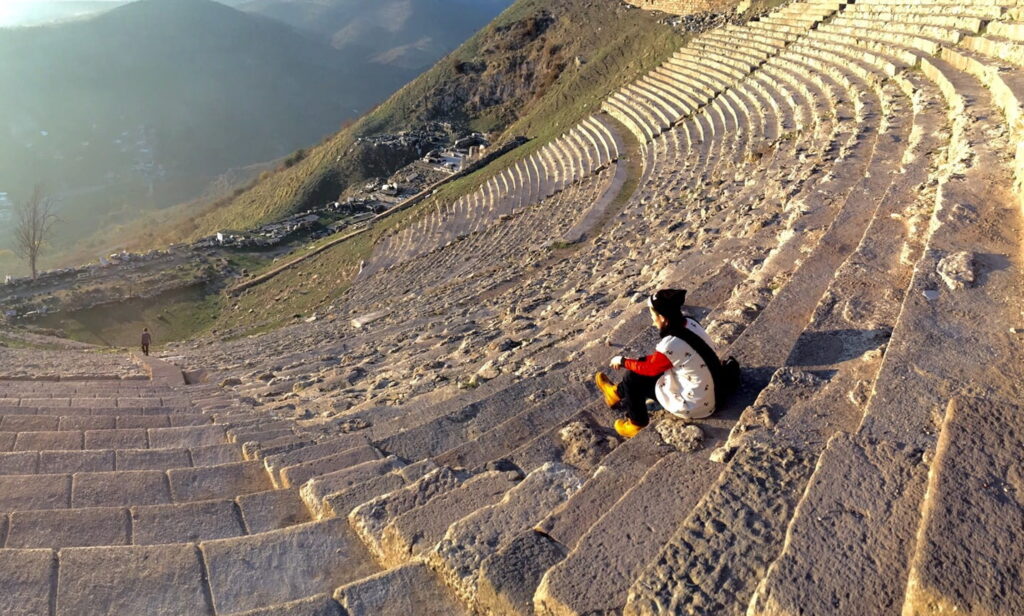
The Citadel Theatre, which seats 10 thousand, was the first theatre of Pergamon and one of the steepest theatres in the world. It is said that the Theater in the acropolis of Pergamum is the steepest raked Hellenistic theater in the world.
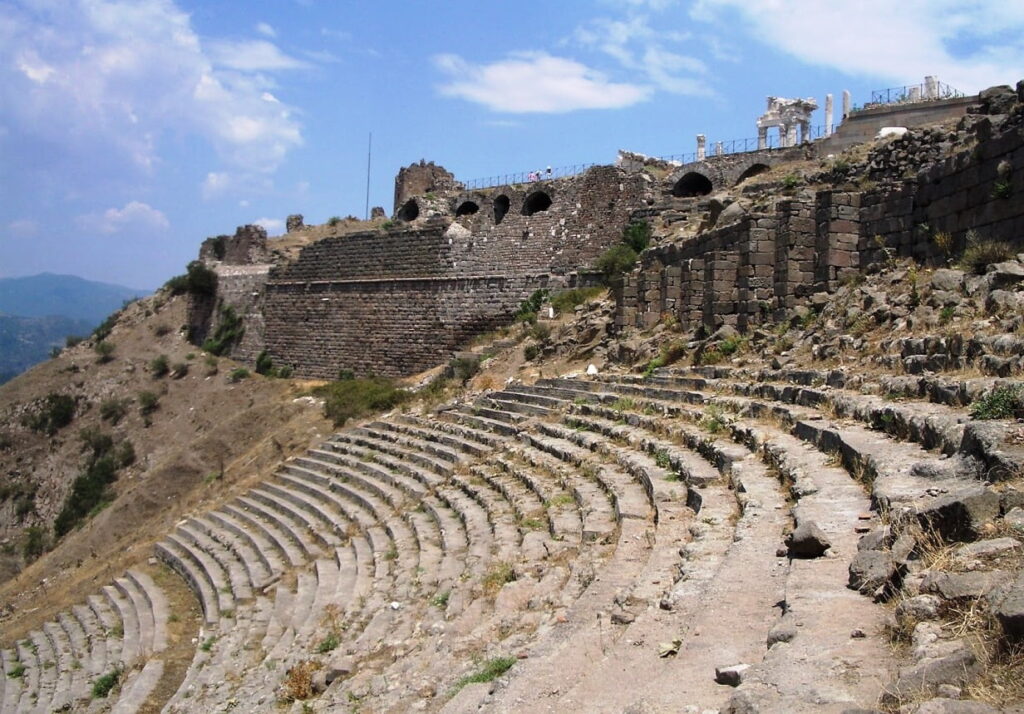
Theatre’s wooden stage had been constructed to be removed when it’s necessary to provide participation of the public in ceremonies, held in the Temple of Dionysos, on the Theatre’s terrace.
Apart from its outstanding steep structure, the theatre is also one of the most authentic examples of Hellenistic architecture with its mobile wooden stage.
Temple of Trajan (no: 28 0n map),
Temple of Trajan (Trajanium) was built in honor of the Roman Emperor Trajan (Traianus) and was built on the highest terrace in the acropolis. Located on the west side of the Acropolis, Trajanium stands out with its magnificent appearance.
Born in Spain in 53 AD, the Roman Emperor Traianus came from a noble family. In 98 AD, at the age of 45, he became Roman Emperor. In 113, at the age of 60, he embarked on an eastern expedition to Asia Minor. He died in 117 on his way back to Rome, at Cilicia Selinus (today’s Gazipasa District of Antalya).
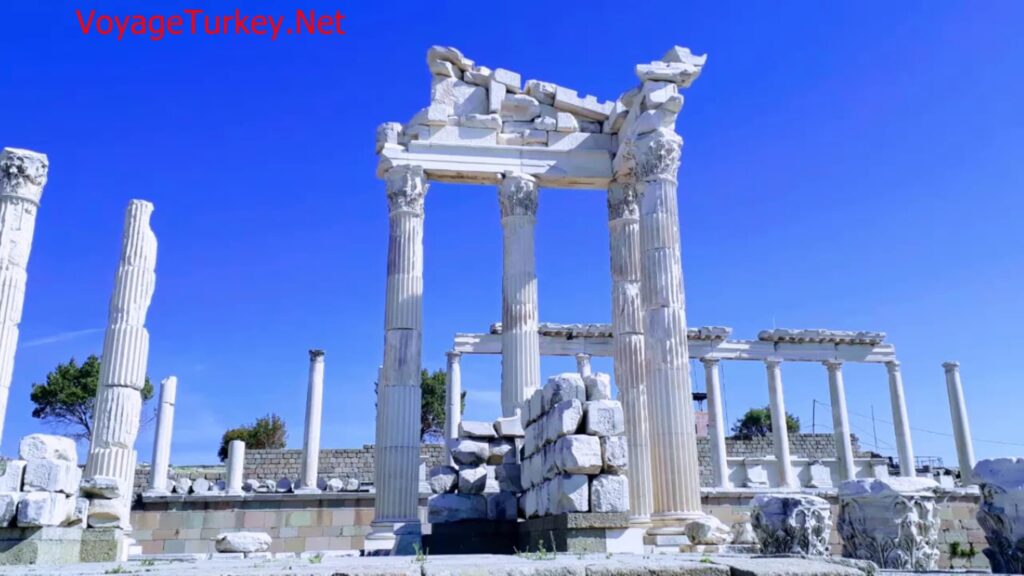
Emperor Hadrianus, who became emperor after Trajan, took the ashes of Trajan to Rome, organized ceremonies for him, and deified him. When Hadrian returned to Pergamum in 125 AD, he ordered the construction of a temple in the name of Traianus on the highest terrace of the Acropolis of Pergamum.
The construction of the temple was completed in 129 AD. It is not known whether Emperor Hadrianus, who was known to have visited Ephesus and Miletus at that time, also visited Bergama and participated in the opening of the temple.
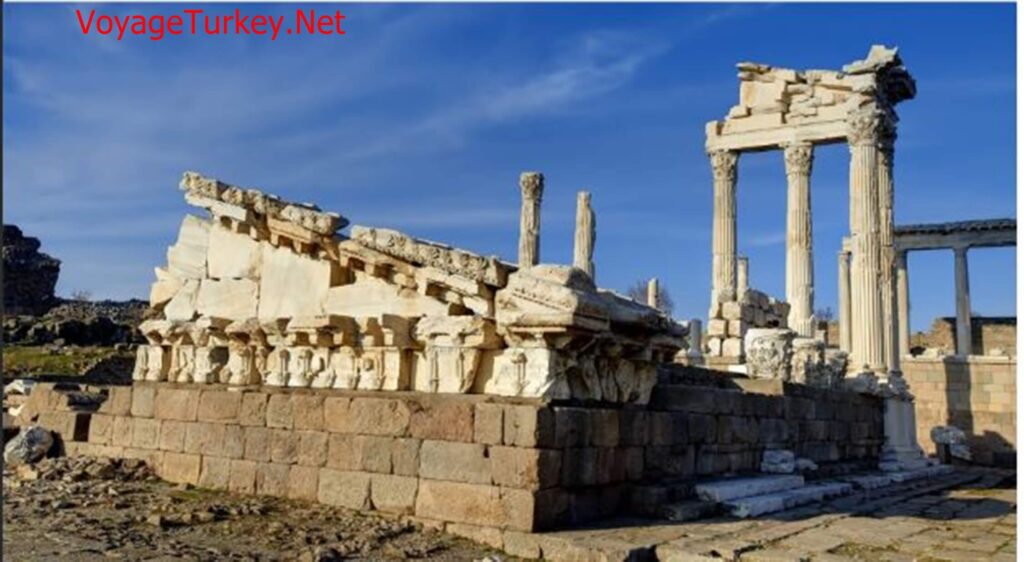
After its completion, the Trajan Temple became the most prominent monument of the fortified hill where the Zeus Altar, the Dionysus Temple, and the theater of the citadel were used to formalize the landscaping of the hill in earlier periods. It is understood that both emperors were worshiped in the temple. The colossal marble statues inside the temple, now exhibited at the Berlin Museum, belong to these two emperors.
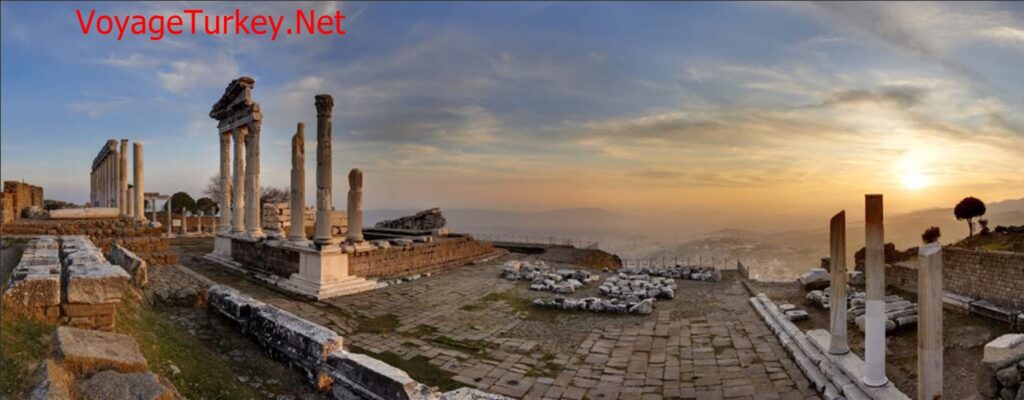
The Temple of Trajanium was built on a 68 m x 58 m terrace at the highest point of the Acropolis. The place chosen for the construction of the temple was first turned into a flat area/terrace with arches and vaults. For this purpose, the foundation of the temple was cut properly and carved up to the bedrock. In this way, five rows of adjacent chambers are formed in three rows. These chambers are covered with vaults. These rooms were transformed into cisterns in medieval.
On one side of the temple, which was built in Corinthian order, there are support walls built for the terrace. The vaulted arches, which appear as a row of windows, were built on the upper edge of the 23-meter-high wall. Shaped as a Peripteros with 6 x 9 columns, the temple is surrounded by stoas on the other three sides.
The destroyed Trajanium Temple was rebuilt in 1976 by a study by the German Archaeological Institute. The restoration of the Temple was completed in 1990.
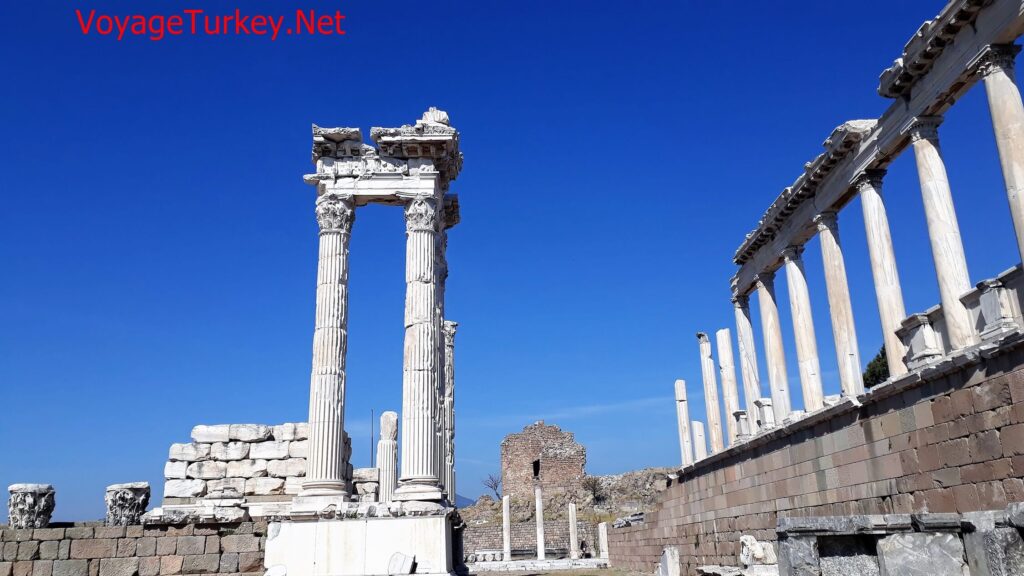
Temple of Dionysos
Dionysos is a dynastic god, accepted as the ancestor of Attalids. Dionysos, having a close connection with the cult of the Hellenistic Pergamon Dynasty, was the “God of Wine and Feast”.
In the 2nd century, the inhabitants of Pergamon built this eye-catching temple on the north of the 250 m. theatre terrace and positioned it in such a way that a view over the whole area was possible.
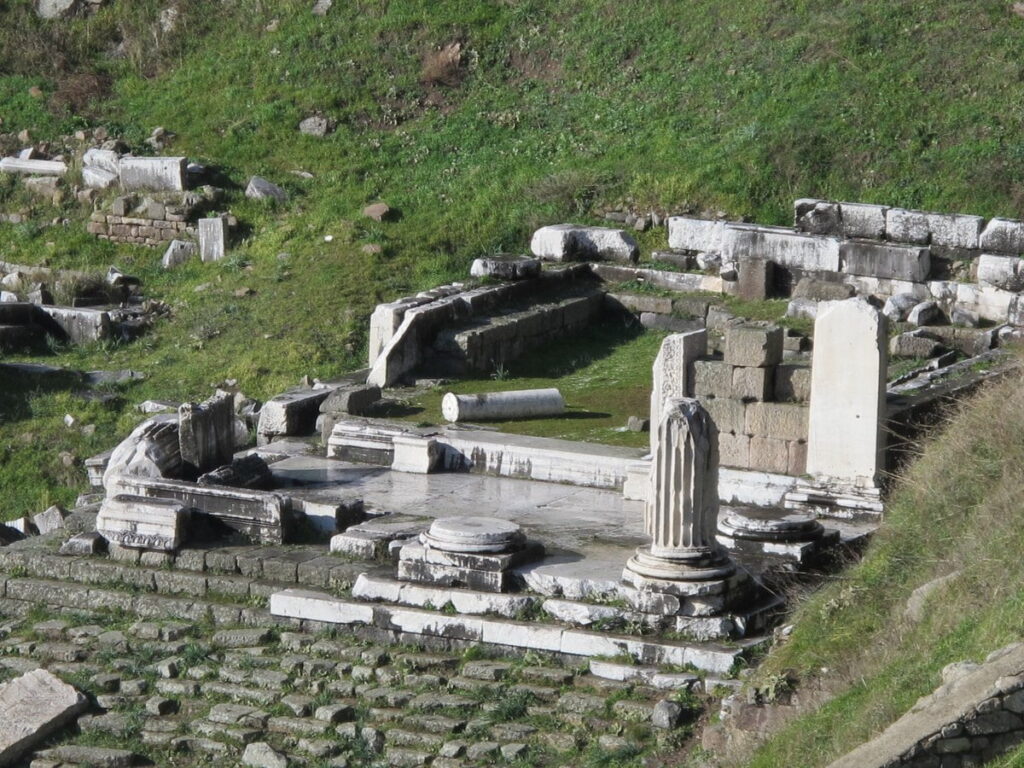
The temple and the altar are both in a well-preserved condition. Rising up on a podium and built according to the Ionian design, it is a richly decorated temple. This work not only affected Roman artistic understanding but also had ramifications on European Baroque architecture. At the end of a long road, this monument has become a work of art that has attracted enormous interest.
Temple was hosting big festivals, organized by the union of Dionysos Dancers and which the public could participate in.
Asclepion and Temple of Asclepius (no: 2 on the map)
An important health care center in ancient times Asclepion situated to the southwest of Pergamon, the Acropolis located in the first settlement on a steep hill at a height of 300 m.
The Asklepion is an ancient medical complex built in the 4th century BC, in honor of the god of healing; Asklepios.
Also known as the first psychiatric hospital the Asklepion became famous during the 2nd century AD. In the Asklepion, patients used to be treated by various cures such as spring water cures, spa, mud bathing, and sporting activities.
The Asklepion was built in honor of Asklepios. Legend has it that Coronis, the daughter of the King of Thessalia, fell in love with a man when she was carrying the God Apollo’s child. Learning of this, Apollo punished Coronis by burning her to death. However, before doing so, he saved the child in her womb, who was later to be named Asclepius.

The child was put into the custody of Horse Man Kherion, so he could raise the child. Kherion made his living using healing waters and herbs, and as he raised Asclepius he taught him the science of medicine. However, the chief God Zeus was upset by Asclepius’ ability to bring the dead back to life, and as a punishment; he killed Asclepius by casting lightning upon him. Deeply saddened, Apollo took his son Asclepius up into the sky, placing him among the zodiacs.
The snake, which is currently used as the symbol of health and medicine, is one of the symbols of Asclepion. Asclepius is depicted as a bearded man wearing sandals on his feet. He is holding a sceptre with a snake wound around it.
Among the historical buildings of the Asclepion temples dedicated to the health god Asclepius can be found. The site is one of the most famous healthcare centers discovered, and indeed is a fascinating place for people to visit.
Historical sources define the health care center built by Arkias, the son of Aristohminos from Pergamon, in the 4th century B.C. as, “the location where death is prohibited and wills are never opened up”. Treatment methods that are
employed in modern times included such practices as; the use of healing waters, mud baths, sports, theatre and psychotherapy, and these were carried out in the center accessed by a columned street.
Built approximately in the year 150, and built from donations received, situated immediately to the left was the Temple of Asclepion. Here treatment using water sounds was employed, as it was suggested that this was beneficial to patients’ recovery.
It is said that the first temple to become Pergamon’s Asclepion, was built on a rocky site near a sacred fountain, in the Ayvazali location. Sources say that the Asclepion reached a considerable state of development and the city was decorated with marble buildings in the Period of Pergamon Kingdom (280 – 133 B.C.).
Suffering a number of wars and devastation in the subsequent periods, the historical centre was rebuilt and expanded, along with Pergamon between 183 – 173 B.C. In that period, there was an Ionian style marble temple rising on the rocks, treatment halls, stone fountains, and a pool was in the process of being built to supply sacred water to the public.
However, in 156 B.C., King Bithynia looted Asclepion, taking with him to his country all the valuable statues and works of art. This included the Statue of Asclepius.
In the period of the Pergamon King Attalos III, the Asclepion Health Centre was called “The Royal Sacred Place”. A statue of the king was placed next to the statue of the god, and animals were slaughtered and given as sacrifices to him.
Asclepion regained its importance in the second half of the first century B.C., with corridors, pools and treatment areas being supplemented between 138 and 161 B.C. The Orator Aristides, a major source for historians, arrived in Pergamon in the 2nd century, and is quoted as saying about the Asclepion: “I owe my health entirely to you, Asclepius and I am tied to you by a mysterious love.”
A colossal earthquake in the 3rd century devastated the buildings. The Temple of Asclepion was used as a church following the spread of Christianity.
The Red Basilica (no: 14 on the map)
The Roman Theatre (no: 8 on the map)
The theatre of the lower city was one of the most important structures of the Roman Period.
It used to seat for up to 30 thousand spectators.
The Amphitheatre (no: 10 in the map)
Pergamon amphitheater used to stand on a natural water source of the “Telli Dere”’ and thus the theatre used to host a reenactment of the naval battles along with the gladiator combats.
50 thousand seated amphitheater represents one of the unique architectural form in Anatolia.
Agoras
Agora was the central spot for public gathering and of the financial-political life of the cities during antiquity. The orders of the Pergamon Kings, written on obelisks, used to be presented in the agoras of the city.
The upper agora is located to the south of the Altar of Zeus. Dedicated to Hermes, the God of Merchants, the agora was built in the Doric style. The foundations of the Temple of Demeter are visible on the western edge of the square.
Gymnasiums
Gymnasiums, in ancient times, functioned as a wrestling, discusing throw, long jumping etc. training facilities for competitors.
In the city of Pergamon, three splendid gymnasiums were built on three separate terraces all in a row. It is understood from inscriptions uncovered that the lower terraces would have been used by children, and the central and upper terraces were allocated to youths and adults respectively.
The Pergamon gymnasiums were not only the greatest nonreligious structures of the city but also the greatest in the Hellenistic world.
